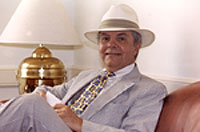There is some question about which would be the first putz on this campus, but our student, Gustavus A. Kavan, 1890, is the first to report on these pranks. Kavan (1865-1959) was a poor boy when he came here as a student in the 1880s, but went on to a distinguished career as a New England attorney and left a scholarship at this school.
He began writing letters around 1937 to Franklyn "Jiggs" Reardon, the English teacher who was long-time mentor for the Reserve Record. Kaven was employed by the school (he was a scholarship boy) and among his jobs was clearing snow in the winter, carrying up the "coal hods", setting the fires in the potbelly stoves in the classrooms, and other menial tasks. He was older than most of the students at WRA but a good observer and a willing participant in the "pranks" (he uses that word) that helped the students get through the school year.
 |
Athenaeum, photo from 1896-97
Taken by George Saywell, Class of 1897
|
Kaven notes that one of the students fooled him by storing a horse in Kaven's room at the Athenaeum, so that when he returned to his room, he opened the door to the back end of the horse (who was a school-owned animal). This was probably around 1887 or '88. Kaven also writes about how he "climbed the belfry of the Chapel" one fall night in 1887 around 2 a.m. He was "armed with a large and unwieldy monkey wrench" and removed the hand of the tower clock. Kaven stored the clock hand in his trunk, and was never found out. Thirty years later he returned the clock hand to none other than James W. Ellsworth (1849-1925), the school benefactor, who wrote him a cordial letter of thanks.
Forty years after this moonlight putz, Kaven sent a letter to Mr. Reardon and this story appeared in the Reserve Record. But Kaven reports yet other pranks from the late 1880's. One involves going out into the country with a group of students and bringing back pumpkins that were placed against the door of "the Slaughter House" (79 Hudson Street) where most of the students had their meals. One of Kaven's buddies wrote on one, "this is Kaven's pumpkin". But the best of Kaven's reported pranks is the match heads strewn over the floor of the lecture hall in the Athenaeum (it was the main classroom building from 1843 to 1903). The matches all exploded when the students came in for class. It's a wonder that this putz did not burn down the entire building.
There are many putzes reported on in the book Without Reserve, edited by Jim Gramentine '52. Don Collister '43 asserts in his article (p.12) that the definition of "putz" is something that occurred often in the mid-1940's usually to relieve "academic tedium."
 |
Terrence D. Garrigan '46
|
Terry Garrigan '46 writes about "liberating" a captive gallon of strawberry ice cream in the kitchen of Ellsworth Hall. That and about ten other putzes are lovingly described by other graduates in this book.
Jeff Green '66 defined a putz as "a highly imaginative prank that required special forces-like execution to avoid discovery and capture." What about the railroad locomotive taken from its tracks, or the weather balloon pressed into a faculty member's new VW Beetle? Or the putz pictured in one of the yearbooks: two VW cars inside Seymour Hall? This was in 1968 and the cars belonged to Bill Moos, the art teacher, and Rollie Waite, the math teacher and assistant Head of School.
 |
VW Beetles inserted inside Seymour Hall, 1968
|
 |
Rollin Waite, Faculty Master
|






















